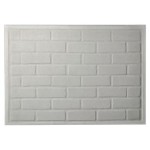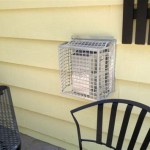How To Build Your Own Outdoor Fireplace
An outdoor fireplace can transform a backyard, creating a focal point for relaxation and entertainment. Building one's own outdoor fireplace is a significant project that requires careful planning, adherence to safety codes, and a commitment to craftsmanship. This article provides a comprehensive guide to the steps involved in constructing a durable and aesthetically pleasing outdoor fireplace.
Planning and Preparation
Before any physical construction begins, a detailed plan is essential. This stage involves several crucial considerations: location, size, design, and local regulations. A well-thought-out plan mitigates potential problems and ensures the project aligns with personal preferences and legal requirements.
Location:
Selecting the ideal location is paramount. Consider proximity to the house, prevailing wind direction, and distance from flammable materials such as trees and fences. A location that is easily accessible but doesn't disrupt foot traffic or landscaping is generally preferable. Also, factor in any underground utilities, such as gas lines or electrical cables, to avoid accidental damage during excavation.
Size and Design:
The size of the fireplace should be proportional to the size of the outdoor space. A massive structure in a small yard can feel overwhelming, while a small fireplace in a large area might appear insignificant. The design should complement the existing architectural style of the house and surroundings. Options range from traditional brick fireplaces to more modern designs incorporating stone, concrete, or metal. Consider the intended use of the fireplace; is it primarily for ambiance, or is it also designed for cooking? This will influence the dimensions of the firebox and the inclusion of features like a grill or smoker.
Materials:
The choice of materials significantly impacts the appearance, durability, and cost of the fireplace. Common materials include brick, stone, concrete blocks, and firebrick. Brick and stone offer a classic aesthetic and excellent heat retention. Concrete blocks provide a more economical option, although they typically require a veneer to achieve a desired finish. Firebrick is essential for lining the firebox, as it can withstand extremely high temperatures. Mortar is another critical material; use a high-temperature refractory mortar specifically designed for fireplace construction. Consider sourcing materials from reputable suppliers to ensure quality and consistency.
Local Regulations and Permits:
Before commencing construction, thoroughly research local building codes and regulations. Most municipalities require permits for outdoor fireplaces, and these permits often specify setback distances from property lines, height restrictions, and chimney requirements. Failure to obtain the necessary permits can result in fines or the forced removal of the structure. Contact the local building department to understand the specific requirements in your area.Constructing the Foundation and Firebox
A solid foundation is fundamental to the stability and longevity of the fireplace. A properly constructed firebox is crucial for safe and efficient combustion. These steps require precision and attention to detail.
Foundation:
Excavate the area for the foundation to a depth specified by local building codes, typically below the frost line. The excavated area should be wider than the base of the fireplace to provide ample support. Pour a concrete footing, reinforcing it with steel rebar for added strength. Allow the concrete to cure completely before proceeding to the next step. The foundation must be level and square to ensure the stability of the entire structure.
Base Construction:
Once the foundation is cured, begin constructing the base of the fireplace. This can be done using concrete blocks, brick, or stone, depending on the chosen design. Lay the first course of blocks or bricks in a bed of mortar, ensuring they are level and properly aligned. Use a level and a square to verify accuracy. Continue laying courses, staggering the joints for added strength. Fill the cores of concrete blocks with concrete for increased stability. The base should be wide enough to support the firebox and chimney.
Firebox Construction:
The firebox is the heart of the fireplace and requires careful construction to withstand high temperatures. Line the interior of the firebox with firebrick, using refractory mortar. Firebrick is specifically designed to handle extreme heat and prevent damage to the surrounding structure. The firebox should have a slightly sloped floor to facilitate drainage. Consider including a damper to control airflow and prevent drafts when the fireplace is not in use. The damper should be sized appropriately for the firebox opening. Ensure the firebox dimensions are adequate for the intended size of the fire.
Smoke Chamber and Throat:
Above the firebox, construct a smoke chamber that gradually narrows to form the throat of the chimney. The smoke chamber helps to direct smoke and gases into the chimney. The throat should be properly sized to ensure efficient draft. The walls of the smoke chamber should be smooth to minimize turbulence and promote upward flow. Use refractory mortar to seal all joints and prevent smoke from escaping.Building the Chimney and Finishing Touches
The chimney is essential for venting smoke and gases away from the seating area. The finishing touches enhance the aesthetic appeal and functionality of the fireplace.
Chimney Construction:
The chimney should extend high enough above the roofline to ensure adequate draft and prevent downdrafts. Consult local building codes for specific height requirements. The chimney can be constructed from brick, stone, or pre-fabricated chimney flue liners. If using brick or stone, line the interior of the chimney with flue liners to protect the masonry from corrosive gases. The flue liners should be properly sized to match the firebox opening. Use refractory mortar to seal the joints between the flue liners. The chimney should be capped with a spark arrestor to prevent embers from escaping and potentially causing a fire.
Veneer and Facing:
Apply a veneer to the exterior of the fireplace to enhance its appearance. This can be done using brick, stone, stucco, or other decorative materials. Prepare the surface by cleaning and roughening it to ensure proper adhesion of the veneer. Apply a layer of mortar to the surface and carefully set the veneer in place. Ensure the veneer is level and aligned. Use a grout bag to fill the joints between the veneer elements. Clean the surface of the veneer to remove any excess mortar.
Hearth Extension:
Extend the hearth (the area in front of the firebox) beyond the firebox opening. This provides a safe surface for embers to fall onto and helps to prevent accidental burns. The hearth can be constructed from brick, stone, concrete, or other non-combustible materials. The hearth extension should be of sufficient size to comply with local building codes.
Final Inspection and Safety Checks:
Before using the fireplace, conduct a thorough inspection to ensure all components are properly installed and functioning correctly. Check for any cracks or gaps in the masonry. Ensure the damper operates smoothly. Verify that the spark arrestor is securely in place. It is advisable to have the fireplace inspected by a qualified professional to ensure it meets all safety standards. This inspection can identify potential problems that may not be apparent to the untrained eye.
Landscaping and Surrounding Area:
Complete the project by landscaping the area around the fireplace. Install seating, pathways, and other outdoor features to create a comfortable and inviting space. Plant fire-resistant vegetation around the area to minimize the risk of fire hazards. Consider adding outdoor lighting to enhance the ambiance and provide visibility at night.
How To Build An Outdoor Fireplace Today S Creative Life

How To Build An Outdoor Fireplace Step By Guide Buildwithroman

How To Build An Outdoor Fireplace Step By Guide Buildwithroman

Diy Building An Outdoor Fireplace

Diy Building An Outdoor Fireplace

How To Build An Outdoor Fireplace
:max_bytes(150000):strip_icc()/milkpaint-286c9ee63b604ca1aaecac5233c8a3f3.jpg?strip=all)
10 Free Outdoor Fireplace Construction Plans

Pima Ii Diy Outdoor Fireplace Construction Plan Designs Patio

How To Build An Outdoor Fireplace Step By Guide Buildwithroman

How We Built Our Outdoor Fireplace Chris Loves Julia
Related Posts








